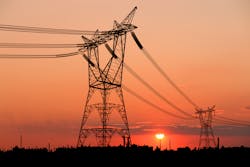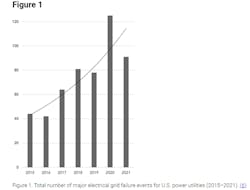Coming amidst another punishing heat wave, news that the globe likely experienced its warmest day ever in July is adding more weight to worries that the nation’s electrical grid is in for some severe testing.
Challenged to reliably deliver power as temperatures rise, air conditioners hum, renewable assets grow, fossil fuel generation wanes, and transmission complexities compound, the grid faces a stress test that could amount to a trial run for tougher times ahead.
More periods of grinding heat, suggested by the July 4 record reading of 62.6ºF for the globe’s average temperature and predictions from the World Meteorological Organization that a five-year trend to ever warmer is in place, would amount to a significant stressor.
The North American Electric Reliability Corporation, which monitors grid readiness, puts “extreme weather events” at the top of its list of threats to grid reliability and stability in its new 2023 State of Reliability report. While overall transmission reliability continues to improve, NERC says the grid is increasingly vulnerable to more frequent and potent demand spikes, especially in its current state of transition. And there’s evidence that outages are increasing. U.S. Energy Information Administration (EIA) data shows grid failures have been increasing (see Figure), and NERC says conventional generation has been at its highest level of unavailability in a decade due to more frequent extreme weather.
Source: Environ. Sci. Technol. 2023, 57, 22, 8245–8255; US Energy Information Administration (USEIA). Electric Power Monthly. 2016–2022
In an agency release, Donna Pratt, NERC’s performance analysis manager, said: “Higher overall outage rates for coal and gas generation, as well as some utility-scale solar generation not operating as necessary for reliability, indicate that there is still significant work to be accomplished to accommodate the rapidly changing weather and generation resource mix in conjunction with electrification of the economy in a reliable manner.”
Foretelling July’s extended North American heat wave, NERC said in a May summer reliability assessment report that two-thirds of the continent could face energy shortfalls due to high demand from extreme heat. While heat wave-related outages have so far proven only scattered, the agency spelled out a worrisome scenario.
Announcing the outlook, Mark Olson, NERC’s manager of reliability assessments said, “Increased, rapid deployment of wind, solar, and batteries have made a positive impact. However, generator retirements continue to increase the risks associated with extreme summer temperatures, which factors into potential supply shortages in the western two-thirds of North America if summer temperatures spike.”
Renewable energy sources have come under the microscope during the current heat wave, drawing praise for rapidly filling a growing generation gap caused by receding fossil fuel sources but some criticism for performance and inherently restricted availability at times of critical peak demand. And NERC highlights performance problems that have been documented with solar PV resources and the critical need to correct them. “The dynamic performance of inverter-based resources (IBR) must be improved if the bulk power system is to benefit from the rapid expansion of this resource.”
Changing weather patterns could prove to be the wild card in determining whether the electrical grid will be able to perform under more intense pressure. Add in expanding electrification, increased renewable energy generation, and battery storage, it’s clear that transmission and distribution – not electrical generation – is fast becoming the overarching power challenge of the future that will demand the focused attention of utilities, government, engineers, and contractors.
Tom Zind is an independent analyst and freelance writer based in Lees Summit, Mo. He can be reached at [email protected].
About the Author
Tom Zind
Freelance Writer
Zind is a freelance writer based in Lee’s Summit, Mo. He can be reached at [email protected].

